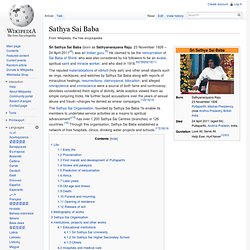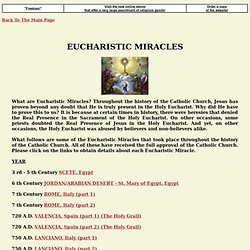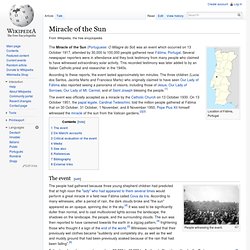

Candy Gunther Brown, Ph.D.: Testing Prayer: Can Science Prove the Healing Power of Prayer? When sickness strikes, people around the world pray for healing.

Many of the faithful claim that prayer has cured them of blindness, deafness and metastasized cancers, and some believe they have been resurrected from the dead. Can, and should, science test such claims? A number of scientists say no, concerned that empirical studies of prayer will be misused to advance religious agendas. And some religious practitioners agree with this restraint, worrying that scientific testing could undermine faith. If prayer affects health -- for better or for worse -- then patients, doctors and policymakers should all want to know. Part of the confusion stems from how prayer is studied. But when people actually pray for healing, they usually get up close to someone they know, touch the person and empathize with their sufferings -- what I call proximal intercessory prayer, or PIP. Camera 1: Medical Records: Are healing claims documented?
Camera 2: Surveys: How do sufferers perceive healing prayer? Candy Gunther Brown, Ph.D.: What Counts as Legitimate Scientific Research on Prayer? I am pleased to see the lively exchange of comments generated by my recent post: "Testing Prayer: Can Science Prove the Healing Power of Prayer? " Many people have raised difficult and important questions that I have been thinking about for years. These questions can roughly be grouped into six categories: scientific methods, evidence, alternative explanations, other studies showing null results, theology and presuppositions. My book, Testing Prayer: Science and Healing, is the outcome of my efforts -- in collaboration with a team of biomedical and clinical researchers -- to work through these questions over the past eight years.
The book traces a history of why empirical research on prayer tends to be controversial (as responses to my blog post illustrate), as well as arguing that -- despite inherent difficulties -- there is reason to pursue such research, and suggesting how researchers might go about it. Sathya Sai Baba. Śri Sathya Sai Baba (born as Sathyanarayana Raju; 23 November 1926 – 24 April 2011[4]) was an Indian guru.[5] He claimed to be the reincarnation of Sai Baba of Shirdi, who was also considered by his followers to be an avatar, spiritual saint and miracle worker, and who died in 1918.[6][7][8][9][10][11] The Sathya Sai Organisation, founded by Sathya Sai Baba "to enable its members to undertake service activities as a means to spiritual advancement"[15] has over 1,200 Sathya Sai Centres (branches) in 126 countries.[16] Through this organisation, Sathya Sai Baba established a network of free hospitals, clinics, drinking water projects and schools.[17][18][19] Life[edit] Early life[edit] His siblings included elder brother Ratnakaram Sesham Raju (1921–1984), sisters Venkamma (1923–1993) and Parvathamma (1928–1998), and younger brother Janakiramiah (1930–2003).[25] Proclamation[edit] Sathya Sai Baba at the age of 14, soon after proclaiming himself as the avatar of Shirdi Sai Baba.

Eucharistic Miracles. What are Eucharistic Miracles?

Throughout the history of the Catholic Church, Jesus has proven beyond any doubt that He is truly present in the Holy Eucharist. Why did He have to prove this to us? It is because at certain times in history, there were heresies that denied the Real Presence in the Sacrament of the Holy Eucharist. On other occasions, some priests doubted the Real Presence of Jesus in the Holy Eucharist. And yet, on other occasions, the Holy Eucharist was abused by believers and non-believers alike. What follows are some of the Eucharistic Miracles that took place throughout the history of the Catholic Church. 3 rd - 5 th Century SCETE, Egypt 6 th Century JORDAN/ARABIAN DESERT - St. 7 th Century ROME, Italy (part 1) 7 th Century ROME, Italy (part 2) 720 A.D. 720 A.D. 750 A.D. 750 A.D. 1010 A.D. 1010 A.D. 1055 A.D.
Miracle of the Sun. Location of Fátima, Portugal The Miracle of the Sun (Portuguese: O Milagre do Sol) was an event which occurred on 13 October 1917, attended by 30,000 to 100,000 people gathered near Fátima, Portugal.

Several newspaper reporters were in attendance and they took testimony from many people who claimed to have witnessed extraordinary solar activity. This recorded testimony was later added to by an Italian Catholic priest and researcher in the 1940s. According to these reports, the event lasted approximately ten minutes. The three children (Lucia dos Santos, Jacinta Marto and Francisco Marto) who originally claimed to have seen Our Lady of Fátima also reported seeing a panorama of visions, including those of Jesus, Our Lady of Sorrows, Our Lady of Mt.
The event was officially accepted as a miracle by the Catholic Church on 13 October 1930. The event[edit] People witnessing the event. De Marchi accounts[edit] Some of the witness statements follow below. Critical evaluation of the event[edit]